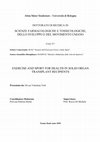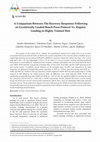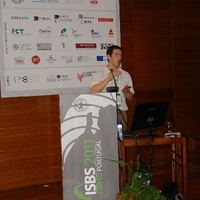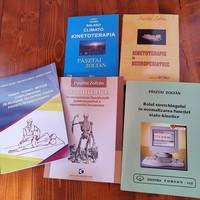Papers by Valentina Totti

19th annual Congress of the European College of Sport Science, 2014
Background Few studies have evaluated the changes in renal function of transplant recipients (TR)... more Background Few studies have evaluated the changes in renal function of transplant recipients (TR) after intense physical activity. Methods The purpose of this study was to investigate some aspects of renal function in TR participating in a road cycling race (CR) of 130km long (total climb: 1871m, uphill 50km, downhill 46km and 34km flat). Venous blood and urine samples were collected: i) the day before (Pre), ii) at the finish (Post), iii) 24 hours (24h) after CR from 20TR (mean\ub1SD age 52\ub110yrs, 72\ub111kg, 173\ub10cm, 24.1\ub12.9kg/m2), who underwent transplant (2 heart, 5 liver, 11 kidney, 2 bone marrow) 8.8\ub14.9yrs before. Forty-four healthy subjects (HS) (52\ub19yrs, 73\ub19kg, 175\ub10cm, 23.8\ub12.2kg/m2) participating to the same race were recruited as control group. From the group of TR, we also collected data from 6 TR who have participated in two editions (2012-2013) of the same race. Results All the participants completed CR without problems. No significant differences were found in the mean race time in both groups (6.36.49\ub11.15.14 vs 6.03.27\ub10.47.24 hh.mm.ss). Significant differences were found between Pre-Post and Post-24h in TR and HS in urea (Pre 45\ub114, Post 68\ub120, 24h 62\ub116 vs Pre 38\ub18, Post 55\ub111, 24h 51\ub17 mg/dL; P<0.05), creatinine (Pre 1.12\ub10.36, Post 1.37\ub10.42, 24h 1.16\ub10.38 vs Pre 0.92\ub10.16, Post 1.09\ub10.22, 24h 0.94\ub10.15 mg/dL; P<0.05), urinary proteins (Pre 148\ub199, Post 341\ub1345, 24h 126\ub1133 vs Pre 73\ub140, Post 116\ub179, 24h 104\ub135 mg/die P<0.05) and microalbuminuria (Pre 54\ub175, Post 192\ub1278, 24h 35\ub159 vs Pre 11\ub118, Post 36\ub144, 24h 8\ub14 mg/L; P<0.05). In both groups values significantly increased between Pre-Post and decreased between Post-24h. In the urine specific gravity values significant differences were found between Pre-24h in both groups (Pre 1.015\ub10.004, Post 1.017\ub10.005, 24h 1.016\ub10.006 vs Pre 1.018\ub10.005, Post 1.020\ub10.005, 24h 1.027\ub10.005; P<0.05) and between groups in 24h (P<0.05). Longitudinally there was no significant difference in Pre, Post and 24h in the two editions of the race. Conclusions TR in good clinical conditions and properly trained, were able to face intense physical effort with transient changes in renal function. The variations observed are superimposable in TR and in HS and have a similar trend. The lower urine specific gravity in TR is related to a tubular dysfunction partially due to immunosuppresive therapy. The increase of proteinuria resolves after rest. More longitudinal studies are necessary to understand the eventual risk of endurance sports activities (CR) for renal function of TR
42° Congresso Società Italiana trapianti di Organo e Tessuti, 2018
importanza dello sviluppo di una rete di professionisti (medici internisti, medici di medicina de... more importanza dello sviluppo di una rete di professionisti (medici internisti, medici di medicina dello sport) per sensibilizzare i pazienti sottoposti a trapianto di rene all'efgfettuazione di attivit\ue0 fisica con e senza supervisione. Il progetto \ue8 stato approvato dal Centro Nazionale Trapiant

Is well known that physical activity reduces rate of cardiovascular and all-cause mortality in th... more Is well known that physical activity reduces rate of cardiovascular and all-cause mortality in the general population and in transplanted recipients. However, most of those investigations present limits. Few data are available on exercise effectiveness on kidney and liver transplant recipients and the correlation between practising exercise, lipid profile and renal function. Additionally, the knowledge on the amount of safe training for sport competitions for this population is limited. This thesis aims to increase the knowledge on the type of exercise and training adapted for transplant recipients and its relative effects on aerobic capacity, strength and quality of life. Moreover, correlation between exercise and blood pressure parameters in solid organ transplant are considered for safeguard of the graft function. The first part of this thesis focuses on the effects of exercise in kidney and liver transplant recipients by health pathways. The second part focus on the sport in sol...
Medicina Dello Sport, 2016

Il manuale per l'allenamento dello sportivo trapiantato d'organo nasce come guida per tut... more Il manuale per l'allenamento dello sportivo trapiantato d'organo nasce come guida per tutti i portatori di trapianto di organo che desiderano praticare attivit\ue0 sportiva. L'importanza dell'allenamento, le sue fasi costituenti sono da subito delineate nella parte introduttiva, per poi passare all'organizzazione di un programma di allenamento specifico per ogni sport. Le schede che accompagnano le varie discipline sportive riportano gli esercizi pi\uf9 idonei per una corretta esecuzione del percorso allenante, dando indicazioni chiare e di immediata comprensione. L'opera si propone infatti di offrire un supporto allo sportivo trapiantato d'organo su come impostare l'allenamento nello specifico sport al fine di migliorare le proprie prestazioni e la propria condizione fisica ottimizzando l'organizzazione di un programma sportivo associato a un miglioramento della qualit\ue0 della vita
Frontiers in Immunology, 2020

Transplantation Proceedings, 2020
INTRODUCTION Despite the well-known benefits of exercise during the pretransplantation and post-t... more INTRODUCTION Despite the well-known benefits of exercise during the pretransplantation and post-transplantation phases, adherence to active lifestyles is still reduced. The aim of the present study is to evaluate how many patients who have received organ transplants and candidates for organ transplantation carry out physical or sports activities in order to increase adherence to an active lifestyle. METHODS The patients who agreed to participate in the study were interviewed about their lifestyle habits by the staff at the nephrology, dialysis, and hepatology units of the Emilia-Romagna region. The interview investigated the patient's lifestyle (active or sedentary) and type of physical activity (walking, cycling, gardening, gym at least 3 to 40 minutes, 2 to 3 times per week) or sport (training > 2 times per week) routinely practiced. RESULTS We collected 1138 interviews from patients on the waiting list (n = 159) for organ transplant, those with kidney transplants (n = 756), and those with liver transplants (n = 223) monitored in the Emilia-Romagna hospitals (regional patients 67%, extraregional 33%). Eighty-four patients on the waiting list for a transplant (kidney) were sedentary, 75 practiced physical activity, and 10 of 75 physically active patients practiced sport. Four hundred fifteen patients with kidney transplants were sedentary, 341 practiced physical activity, and 31 of 341 physically active patients practiced sport. Among patients with liver transplants, 56 were sedentary, 167 practiced physical activity, and 20 of 167 physically active patients played sport. CONCLUSIONS In-line with the general population, we confirmed a high tendency toward a sedentary lifestyle (44% of respondents) among patients with organ transplants and those on waiting lists for organ transplants. Including a prescription for physical exercise as part of the therapeutic regimen can be useful for changing lifestyles during the pre- and post-transplantation period.
International Journal of Sports and Exercise Medicine, 2018
Transplantation Proceedings, 2019
Transplantation Proceedings, 2019

Journal of Human Kinetics, 2019
The purpose of this study was to compare the physiological responses of a single bout of an eccen... more The purpose of this study was to compare the physiological responses of a single bout of an eccentric accentuated bench press protocol (120% of 1RM in the eccentric phase/80% in the concentric phase; [120/80]) versus a regular high-intensity exercise protocol (80%/80%; [80/80]) in resistance-trained men. Eleven men (age = 25.6 ± 3.9 y; body mass = 84.6 ± 11.2 kg; body height = 176.4 ± 3.9 cm) with 6.3 ± 3.4 y of resistance training experience performed each protocol in counterbalanced, randomized order. Isometric, isokinetic and ballistic tests were performed at the bench press (IBPF, ISOK and BTP, respectively) at baseline (BL), 15-min (15P), 24-h (24P), and 48-h (48P) post-exercise for each testing session. In addition, muscle thickness of the pectoralis major (PecMT) was measured at the same timepoints via ultrasound. Significantly greater reductions in BTP (p < 0.001), peak force during both ISOK (p = 0.005) and IBPF (p = 0.006) at 15P were detected in 120/80 compared to 80/8...

Journal of Strength and Conditioning Research, 2019
Bartolomei, S, Totti, V, Griggio, F, Malerba, C, Ciacci, S, Semprini, G, and Di Michele, R. Upper... more Bartolomei, S, Totti, V, Griggio, F, Malerba, C, Ciacci, S, Semprini, G, and Di Michele, R. Upper-body resistance exercise reduces time to recover after a high-volume bench press protocol in resistance-trained men. J Strength Cond Res 35(2S): S180–S187, 2021—The aim of this study was to compare the effects of active and passive strategies on the recovery response after a high-volume bench press protocol. Twenty-five resistance-trained men (mean ± SD: age = 25.8 ± 3.6 years; body mass = 87.1 ± 12.1 kg; and height = 177.4 ± 4.9 cm) performed a high-volume bench press session (8 sets of 10 reps at 70% of 1 repetition maximum). Subsequently, they were randomly assigned to an active recovery (AR) group (n = 11) or to a passive recovery (PR) group (n = 14). Active recovery consisted of light bench press sessions performed 6 hours and 30 hours after the high-volume exercise protocol. Muscle performance (bench throw power [BTP] and isometric bench press [IBP]) and morphology (muscle thickne...

World journal of transplantation, Jan 24, 2018
To evaluate the effect of a 12-mo supervised aerobic and resistance training, on renal function a... more To evaluate the effect of a 12-mo supervised aerobic and resistance training, on renal function and exercise capacity compared to usual care recommendations. Ninety-nine kidney transplant recipients (KTRs) were assigned to interventional exercise (Group A; = 52) and a usual care cohort (Group B; = 47). Blood and urine chemistry, exercise capacity, muscular strength, anthropometric measures and health-related quality of life (HRQoL) were assessed at baseline, and after 6 and 12 mo. Group A underwent a supervised training three times per week for 12 mo. Group B received only general recommendations about home-based physical activities. Eighty-five KTRs completed the study (Group A, = 44; Group B, = 41). After 12 mo, renal function remained stable in both groups. Group A significantly increased maximum workload (+13 W, = 0.0003), V'O peak (+3.1 mL/kg per minute, = 0.0099), muscular strength in plantar flexor (+12 kg, = 0.0368), height in the countermovement jump (+1.9 cm, = 0.0293)...
Transplantation Direct, 2015











Uploads
Papers by Valentina Totti